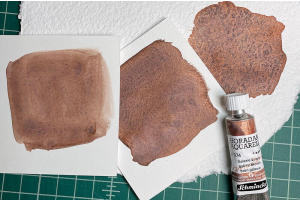We use cookies to make your experience better. To comply with the new e-Privacy directive, we need to ask for your consent to set the cookies. Learn more.
Cheap Joe’s Art Stuff Art Blog
Tips, Tricks, Thoughts, and inspiration from across the art spectrum.
Tempera and Watercolor: Are They the Same?

I was recently asked by a customer, what is the difference between tempera paint and watercolor. She went on to say that they are both water-based and are both re-soluble, however, the two are very different, indeed! Let us begin with the definition.

Tempera Paint is defined as paint that consists of dry pigment and a glutinous water-soluble binder, usually some type of sizing. This could refer to several types of paints, including egg tempera, made with egg yolks, as well as casein paints, which are made with milk. These paints can be perishable when in liquid form, however, when they cure they can last for hundreds of years.
This type of tempera is not what my customer was referring to. She was talking about poster paint, which is also a type of tempera that uses gum water or glue based sizing for its binder. The pigment is usually a colored powder, unlike watercolor, which uses natural pigments and minerals that can be hazardous. Poster paint is great for use in children’s projects as it is non-toxic and washes out very easily. You can buy it as a liquid or as dry powdered paint. It is very inexpensive and unfortunately can fade over time.
As for watercolor paint, it is a more dependable medium. It is formulated to be lightfast and has a high concentration of pigments. Professional watercolors are designed to last for years without fading. The basic makeup of watercolors, in general, is as follows:
1) Concentrated Dry /Natural Pigments and Minerals – These are usually by-

products of the auto industry, which mines the pigments for their auto paints.
2) Binder/Gum Arabic – The vehicle in which the pigment is distributed with.
3) Plasticizer – Glycerin, which softens the gum Arabic and helps it to re-dissolve.
4) Humectant – corn syrup or honey- which helps the paint retain its moisture.
5) Extender/Dextrin – a filler which bulks out the paint without diluting the color. In a student grade paint, there is more of this filler and less pigment, making the paint more affordable.
6) Dispersant – keeps paint from clumping
7) Water – which suspends the pigment and vehicle and carries it to the paper and then evaporates to leave the paint adhered to the paper.
The basic concentration of pigment in watercolor paint is 20-50% pure pigment. This is determined by the degree of tinting ability in the pigment itself. Colors like the Phthalo’s and Alizarin Crimson require a less percentage than colors like Ultramarine Blue and most yellows. The rest of the percentage is what holds the paint together and keeps it moist. Watercolor paint is designed to be controlled by the water itself. The way you apply the water and pigment determines the results. It is very important as a watercolorist that we use the best quality materials that we can afford. This will help to ensure the success of our paintings.
Different mediums are developed for different uses. They are best used for what they were designed to do. Therefore, and in conclusion, although poster paints and watercolor pigments have some similarities, they are ,however, very different mediums! Art comes down to creating, creating requires being inquisitive, and questioning the properties of mediums brings to us many new and wonderful discoveries and techniques. Happy Discoveries!







